This feature is our August 2018 cover story for That's Shanghai, That's Beijing and That's PRD. Check out the full issues online here.
Kiki Chenshu got into the wine business because she was lonely.
When she moved back to her native Yinchuan, Chenshu felt she could no longer relate to her childhood friends. She had gone to university in Beijing to study urban development, then moved abroad, dreaming of one day working for the UN. Back home, she no longer fit in.
“For me, the things I care about, they don’t care about,” she says. “I care about what happens internationally. They just care about buying houses and cars. It’s been really hard.”
Yinchuan is a small city by Chinese standards (its population is a meager 2 million). It’s the capital of Ningxia Hui Autonomous Region, which is a sliver between China’s western Gansu and Shaanxi provinces. Over 30 percent of the region’s population is Hui, a Chinese ethnic minority group that practices Islam.
Growing out of one’s hometown is a tale as old as time – but what is novel about Chenshu’s story is her surprise happy ending.
Just after her return, Chenshu discovered a group of foreigners – seven winemakers from seven different countries, in town to work with local vineyards. “I didn’t have anything to do,” she says, so she helped translate throughout their stay.
Chenshu doesn’t drink wine – most people in Yinchuan don’t – but she and the winemakers became fast friends regardless. Soon after, she landed a job as an assistant for a New Zealand winemaker consulting for a local vineyard, and she’s been working with Ningxia vintners ever since.
Today, Chenshu is on the forefront of Ningxia's most booming industry.
The seven winemakers she met in 2012 had been flown in for Ningxia’s first-ever International Winemaker Challenge. For the 2017 Challenge, 48 came. The number of wineries bottling and selling their wines has also skyrocketed from 20 to 86, according to Chenshu, and in total, 200 wineries are now registered.

Award-winning local wines are displayed at the Wine Bureau's museum (photo via Noelle Mateer/That's Beijing)
Not only are Ningxia wines numerous, they’re award-winning – the region’s vintages have scored top marks in the prestigious Decanter World Wine Awards since 2012, when local winery Helan Qingxue’s Jiabeilan variety won Ningxia’s first regional gold.
The ability of Ningxia wines to hold their own in an international market is no longer a secret – at least among winemakers. But the similarities between Ningxia’s wine industry and that of those abroad stop there.
Whereas the world’s other wine regions are often built on longstanding family chateaux and local wine-drinking cultures, Ningxia has no history of wine-drinking to speak of (in fact, a good percentage of the local Muslim population doesn’t drink at all). Instead, Ningxia’s industry is boosted by a provincial-level Wine Bureau – the only bureau of its kind in all of China – that has effectively built a wine region from scratch.
The result is a small, tight-knit community of wine pioneers leading Ningxia’s fastest-growing industry.
“This is a small place,” Chenshu tells me. “Everyone knows everyone.”
Then, as if to prove her point, she offers to drive me to Kanaan.
Wang Fang, who goes by ‘Crazy Fang,’ despite seeming perfectly sane and friendly throughout our visit, runs Kanaan Winery, one of Ningxia’s most successful brands. Kanaan’s wines have been sold in Australia, Canada, Switzerland and the UK. Crazy proudly shares that her ‘Pretty Pony’ wine is on the list at a famous London restaurant alongside noted French labels such as Château Lafite. “If a Chinese wine is on the same list [as those wines], then what do you think that says about the wine?”

Wang 'Crazy' Fang poses with wines in her cellar at Kanaan
Making good wine in Ningxia is feasible, but difficult. Ningxia is dry, and much of it is desert. The nearby Yellow River makes irrigation possible, but winters here are so windy that each winery hires hundreds of temp workers each fall to bury their vines underground, and dig them up again every spring.
“[My father] used to be a civil servant in the science and technology department of the government, responsible for agriculture,” Crazy says. “He met many professors from around the world, and they told him that the East foot of the [Helan] mountains could be the best terroir [wine-growing region] for grapes.”
Crazy’s father then began planting grapes on the land that would one day become Kanaan’s. “Only a few people trusted my father’s word, but these people had money and power. So that’s decisive,” she says.
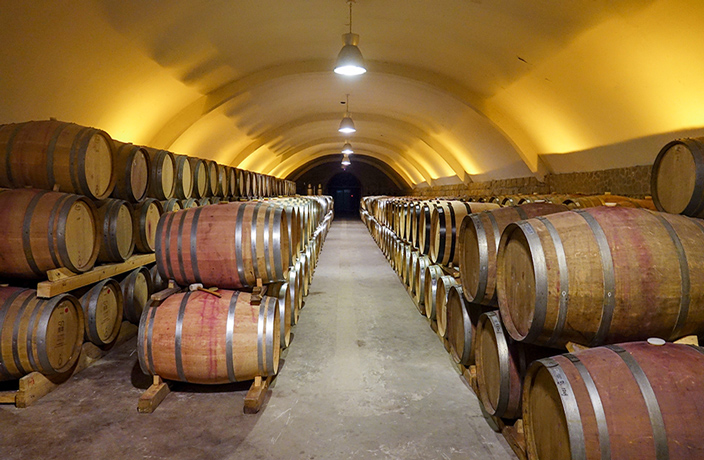
Wine ferments in barrels at Kanaan Winery (photo via Noelle Mateer/That's Beijing)
Ningxia’s agriculture bureau also launched its own vineyard, Xixia King, named after the Western Xia dynasty, who fell at the hands of the Mongols.
Ningxia is dotted with the crumbling, sand-colored remains of Xia rule. On our way from Kanaan to winery Silver Heights, the landscape becomes more desert-like, a flat plain from which the Helan Mountains appear to jut out of unexpectedly. The only glimpse we catch of modern life along the way is a colossal parking lot filled with tour buses. It’s a sort of Universal Studios for Western China, Chenshu explains as she drives. Red Sorghum, the film based on the Mo Yan novel of the same name, was filmed here in 1988.
Just like the mountains, Silver Heights appears to spring from nowhere.
“The challenge was that there was nothing here. It was desert,” says co-founder Thierry Courtade, in a lilting countryside French. “We had to get rid of all the rocks and stones.”
Courtade runs Silver Heights alongside his wife Emma Gao, a native of Yinchuan. The two often act as de facto ambassadors for Ningxia wines, Gao’s Ningxia heritage and Courtade’s family history of French winemaking lending them a collective measure of authority. Search ‘Ningxia wines’ online, and you’re bound to see photos of Gao smiling in her vineyards. (During my own visit, she’s traveling to promote her wine elsewhere in China.)
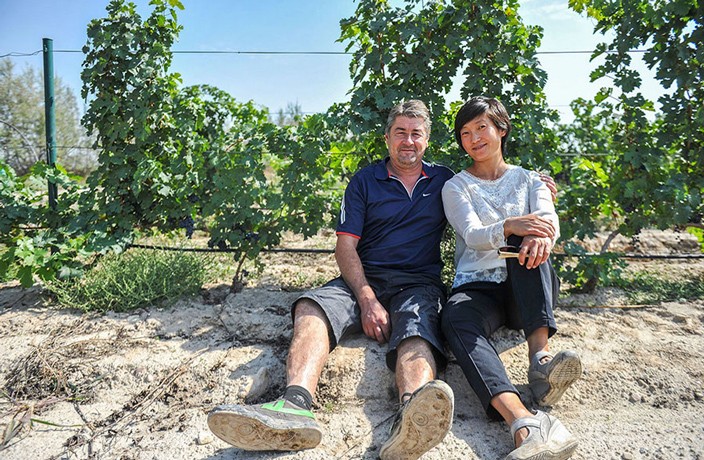
Thierry Courtade and Emma Gao at their winery, Silver Heights (photo courtesy of Silver Heights)
“Each region has its own style. This wine,” Courtade says, holding up a glass of his Last Warrior red, “is a bit sugary. And the rocks here, from the mountains, they give it a mineral flavor. It’s a bit like St. Emilion,” he says, referencing the famed region of his native Bordeaux.
Business is good. “Every year we plant one or more additional hectares,” he says.
But he has someone to thank: the Wine Bureau. “They’ve done everything to develop the region,” he say. “They bring us water, they bring us electricity. They want Ningxia to be the best wine region in China.”
Those unfamiliar with Chinese wine might think this an easy goal. Chinese wines have long suffered from a reputation for poor quality, and even within China, the most popular Chinese wines are the low-quality convenience store varieties by Great Wall. As recently as a decade ago, many China-made ‘wines’ were just grape juice with cheap alcohol mixed in.
“The challenge was that there was nothing here. It was desert.”
But the country’s wines have grown in prominence over recent years, and today’s medal-winning vintages come from regions as varied as Xinjiang, Shandong and Hebei. Tianjin, meanwhile, has the longest history of selling and marketing wine – the first foreign-Chinese joint venture opened there just after Reform and Opening Up with the founding of Sino-French Tianjin Dynasty Wine Company.
And so, Ningxia’s Wine Bureau takes its job seriously. Very seriously: The Bureau itself is a hulking 17-story complex, one side of which is housed in a massive, modernist interpretation of a wine barrel. We pass through several checkpoints just to get inside, where, at the staff canteen, legions of professional wine bureaucrats slurp noodles beneath murals of grapes. The Bureau director we meet there is too busy to speak with us, but suggests we help ourselves to the cafeteria desserts instead.

Ningxia's WIne Bureau resembles a wine barrel (photo via Noelle Mateer/That's Beijing)
“You’ve probably heard about Ningxia wines because the government promotes it so much,” sommelier Ashley Gao tells me later, from her workplace in Beijing, luxury hotel The Opposite House.
Gao is more familiar with wine in Beijing’s neighboring Hebei province, where she got her first job out of university, growing grapes among the same mountains that will host the Winter Olympics in 2022.
“They make really good wines there,” she says. “And it’s the closest wine region to Beijing.”
Ningxia’s distance from Beijing makes its wine harder to get. “I’ve been to Ningxia and I love the wines there,” she says. “But a lot of them don’t have distributors.”
“You’ve probably heard about Ningxia wines because the government promotes it so much.”
While many of the region’s wineries have perfected the art of making wine, they are less well versed in selling it. The region’s most prominent boutique wineries, like Kanaan and Silver Heights, work with distributors to sell their wine elsewhere in China, but they don’t have the capacity to mass-produce, which makes their product expensive.
Kiki Chenshu tells me this is something the Bureau is working on. Whereas the Bureau’s previous director focused on developing boutique wineries, now, “they are thinking we should have some famous brands.”
One such brand could be Chandon.
Chandon is one Chinese wine Ashley Gao is able to serve a lot of. The sparkling wine brand is a project by LVMH (Louis Vuitton Moët-Hennessy, of Moët & Chandon Champagne), who establish wineries throughout the world to produce sparkling wines for various markets. (Any sparkling wine produced outside the region of Champagne cannot be called Champagne.)

State-of-the-art machines bottle sparkling wine (photo via Noelle Mateer/That's Beijing)

Wine production facilities (photo via Noelle Mateer/That's Beijing)
Thanks to the backing of their parent company, plus a built-in network of distributors, this year Chandon has made waves in hotels and restaurants in first-tier cities. It’s The Opposite House’s go-to sparkling for brunches at its Chinese restaurant, Jing Yaa Tang.
Chandon’s China property is just a few minutes’ drive from a crumbling section of the Great Wall, on Ningxia’s border with Inner Mongolia. But inside its visitor center, it feels like Europe – gleaming white walls and plush couches, a long granite countertop for hosting tastings.
Inside, the site manager plays a slickly produced promotional video on the center’s flatscreen TV. “Our target is young, upper class people from first-tier cities,” she says, as a bride on screen holds her glass up to the camera.
The real thing to see here, however, is the view. And so, sparkling wine flutes in hand, we walk up to the roof of the visitors’ center and gaze across the vineyards.
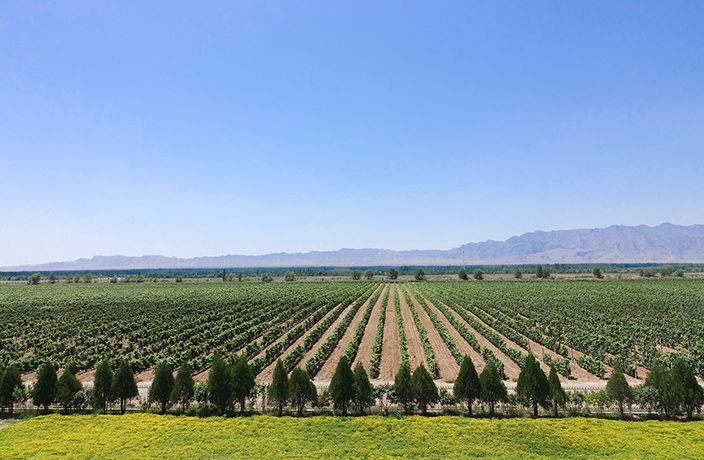
Ningxia's Helan Mountains are visible from Chandon's vineyard (photo via Noelle Mateer/That's Beijing)
It’s a crystal-clear day in Ningxia, and vines stretch in front of us for miles. Only some of them are the pinot noir and Chardonnay grapes of Chandon – the rest belong to countless other wineries, trying to cash in on this booming industry. “See that blue building over there?” says the manager. “That’s COFCO’s winery. It’s the biggest in Ningxia.”
“You can make plans for the short term, but for the long term, it’s nearly impossible. My mind could change, the policies could change.”
At Kanaan, when I ask Crazy Fang if she, too, would like to expand to have a more corporatesized wine venture, she says, “this is enough. I already haven’t had a vacation in years.
“When you’re in China, you can make plans for the short term, but for the long term, it’s nearly impossible,” she explains. “My mind could change, the [local bureau] policies could change. I would never say I hope that this vineyard goes on for 100, 200, 300 years. This is not negative, this is the reality.”
We're in her living room now, sipping her fruity Riesling. Crazy twirls her glass, watching the sunlight glint off the yellow liquid.
“But the wine industry will continue in Ningxia. There is no doubt,” she says, smiling. “People need wine.”
 This feature is our August 2018 cover story for That's Shanghai, That's Beijing and That's PRD. Check out the full issues online here.
This feature is our August 2018 cover story for That's Shanghai, That's Beijing and That's PRD. Check out the full issues online here.




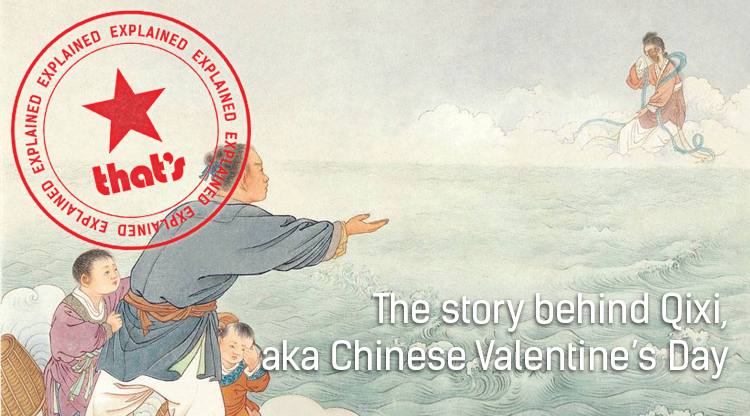
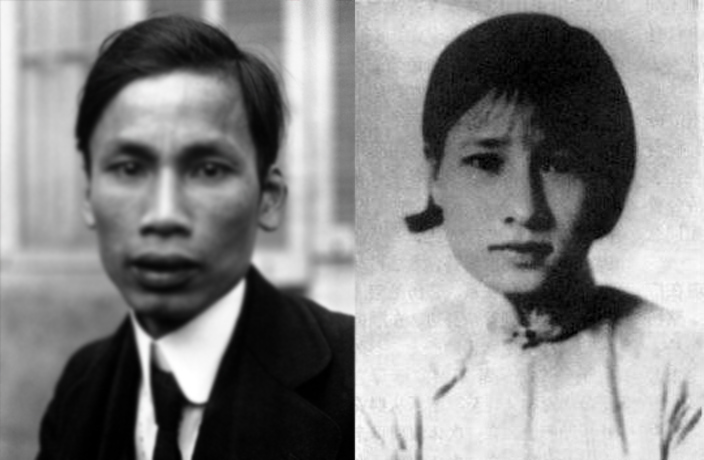















0 User Comments